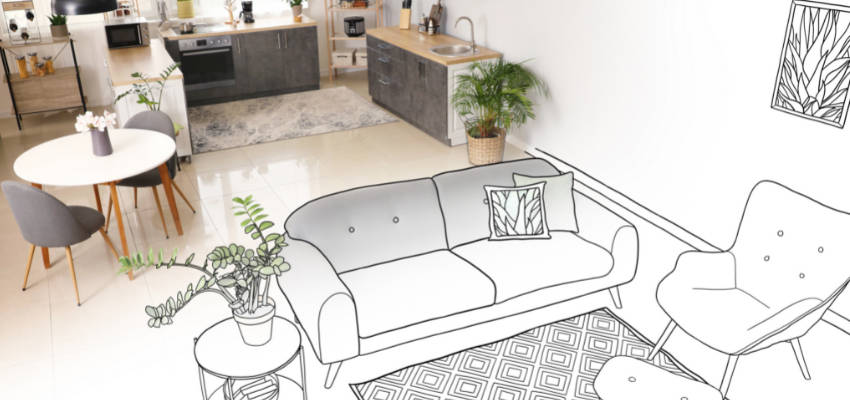Show:
5 Technological Trends In Furniture eCommerce
In recent years, the furniture industry has seen a surge in e-commerce sales, with more and more consumers opting to shop for furniture online. As a result, furniture retailers have been embracing technology to provide their customers with an immersive and interactive online shopping experience.

We will explore five technological trends in furniture e-commerce, including room visualizer furniture and 3D product visualization.
Room Visualizer Furniture
One of the biggest challenges of shopping for furniture online is visualizing how it will look in your home. Room visualizer furniture technology addresses this issue by allowing customers to see how a piece of furniture will look in their space before making a purchase.
With this technology, customers can upload a photo of their room and place virtual furniture in the space, allowing them to see how it will look and fit in their home. This technology not only helps customers make more informed purchasing decisions and reduces the number of returns and exchanges.
3D Product Visualization
Another technological trend in furniture e-commerce is the use of 3D product visualization. With 3D furniture visualizer, customers can view a product from all angles and zoom in to see the details.
This technology provides a more detailed and immersive view of the product, which helps customers make informed purchasing decisions. 3D product visualization benefits products with intricate details or unique shapes that may be difficult to capture in 2D images
Augmented Reality
Augmented reality is another technology that is transforming the furniture e-commerce industry. With augmented reality, customers can use their smartphone or tablet to place virtual furniture in their space, giving them a realistic view of how it will look in their home.
This technology helps customers visualize how the furniture will look and fit in their space, reducing the likelihood of returns and exchanges. Augmented reality is also helpful for retailers, as it allows them to showcase their products in a new and innovative way.
Chatbots
Chatbots are another technological trend that is becoming increasingly popular in furniture e-commerce. Chatbots are automated messaging systems that can assist customers with their purchases.
Customers can ask questions about products, receive recommendations, and even purchase through the chatbot. Chatbots provide customers with a convenient and personalized shopping experience, and they are available 24/7, which makes them a valuable asset for furniture retailers.
Virtual Showrooms
Virtual showrooms are another technological trend that is transforming the furniture e-commerce industry. With virtual showrooms, customers can explore a retailer’s entire collection of products in a 3D environment.
Customers can browse different products, view them from all angles, and interact with them. Virtual showrooms provide customers with a more immersive shopping experience, which can increase engagement and sales.

Marketing Strategies To Grow Your Furniture eCommerce
In the competitive world of furniture e-commerce, it’s essential to have a solid marketing strategy to grow your business. Whether you’re just starting or looking to take your furniture e-commerce business to the next level, here are four effective marketing strategies to consider.
1. Focus on Personalization
Personalization is essential for furniture e-commerce retailers because it can help you stand out and provide a better customer experience. You can increase engagement and loyalty by tailoring your marketing messages and product offerings to individual customers.
Personalizing your marketing involves many ways, such as offering personalized product recommendations, sending personalized emails, and creating customized landing pages. One effective way to personalize your marketing is using customer data to create targeted marketing campaigns.
By analyzing purchase history, browsing behavior, and demographic information, you can create more relevant and personalized marketing messages that are more likely to resonate with individual customers.
2. Use Visual Content
Visual content is a powerful marketing tool for furniture e-commerce retailers because it allows customers to see and experience your products before they buy. High-quality images, videos, and interactive product visualizations can help customers visualize how your products will look in their homes and make more informed purchasing decisions.
One effective visual content strategy is 3D product visualization and room visualizer technology. These tools allow customers to see your products in realistic 3D environments and visualize their appearance in their homes. This can help increase customer engagement and reduce the number of returns due to mismatched expectations.
3. Optimize Your Website for Mobile
In today’s mobile-first world, furniture e-commerce retailers need to optimize their websites for mobile devices.
This means ensuring your website is fast, easy to navigate, and optimized for mobile screens. Mobile optimization can help improve the user experience and increase conversion rates as more and more customers shop for furniture on their mobile devices.
In addition to optimizing your website for mobile, it’s also essential to consider mobile-specific marketing strategies such as SMS marketing and mobile app advertising. These channels can help you reach customers on the go and provide a more seamless shopping experience.
In Conclusion
Technological advancements are transforming the furniture e-commerce industry, providing customers with a more immersive and interactive shopping experience. Room visualizer furniture, 3D product visualization, augmented reality, chatbots, and virtual showrooms are just a few examples of the technologies that are shaping the future of furniture e-commerce.
As technology evolves, we expect to see even more innovative solutions to enhance furniture customers’ online shopping experience.

 Return to Previous Page
Return to Previous Page








